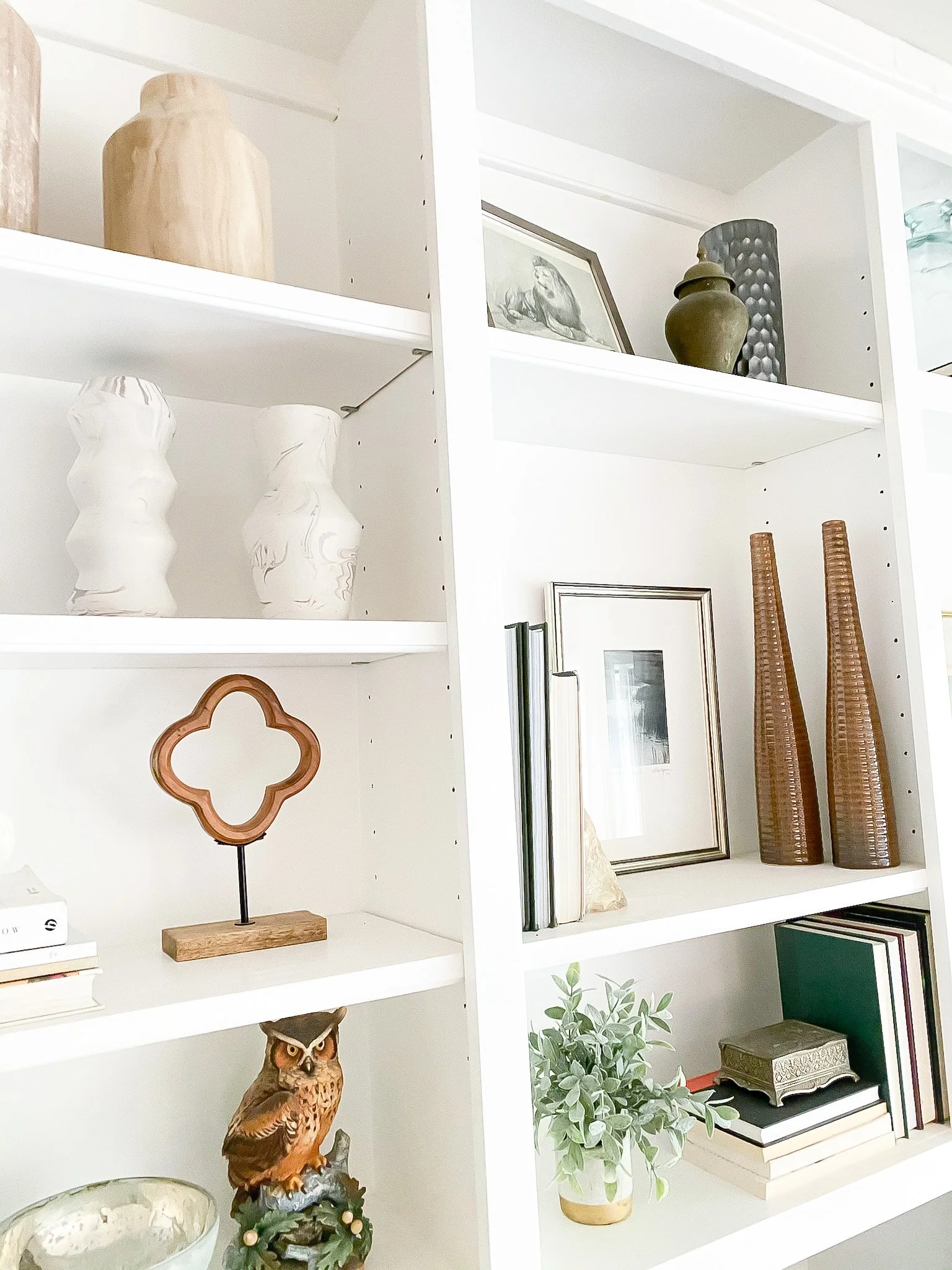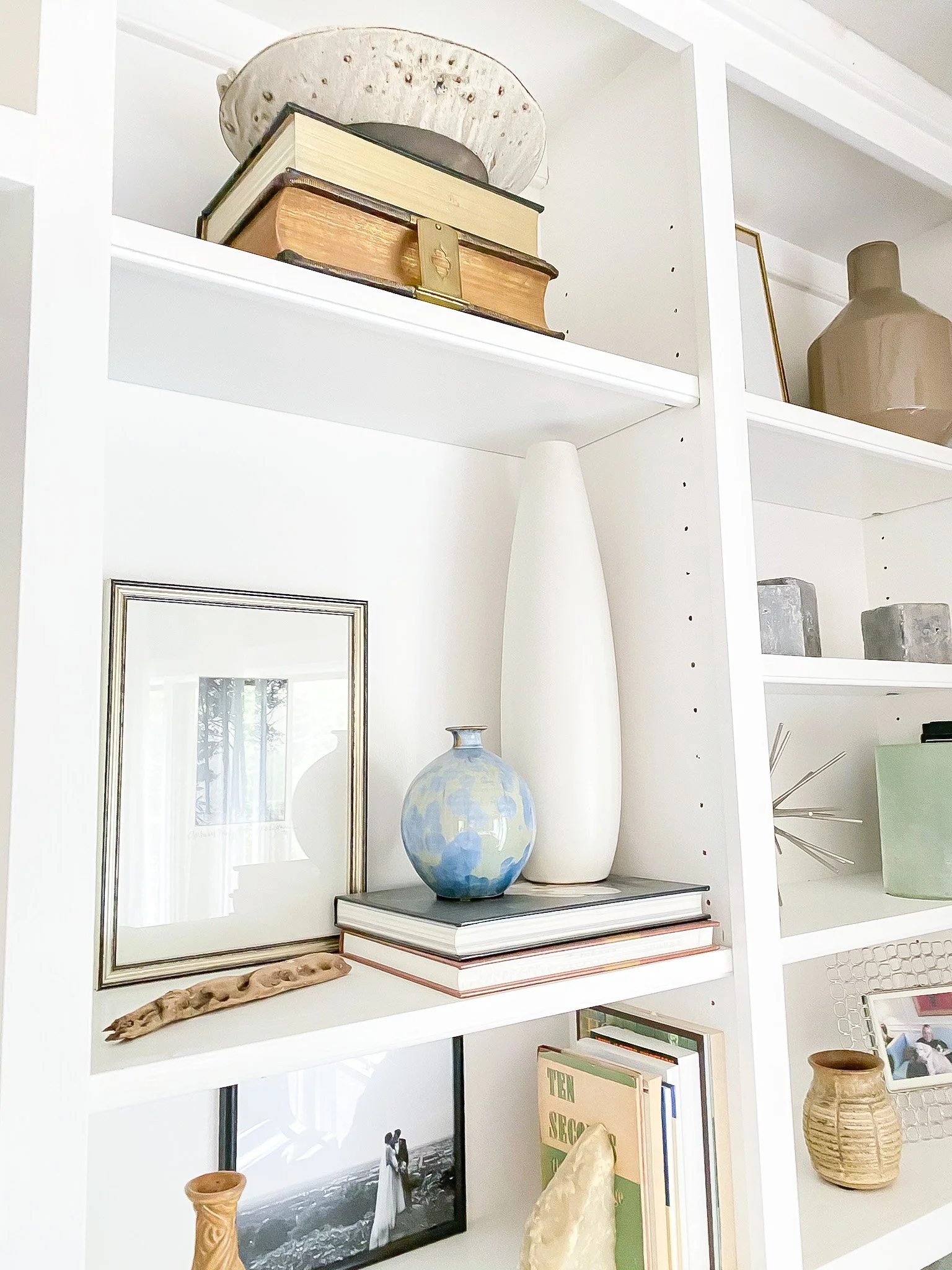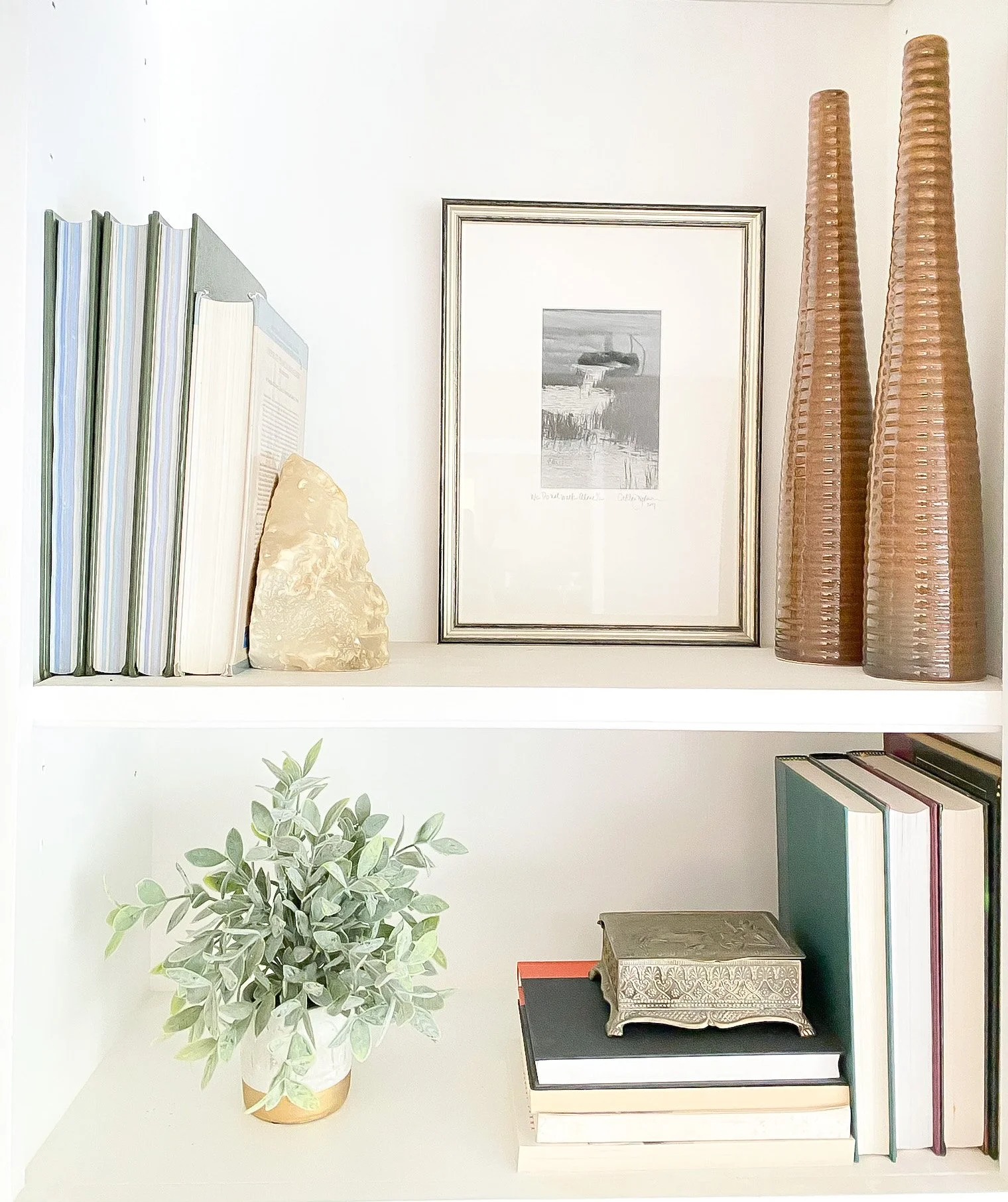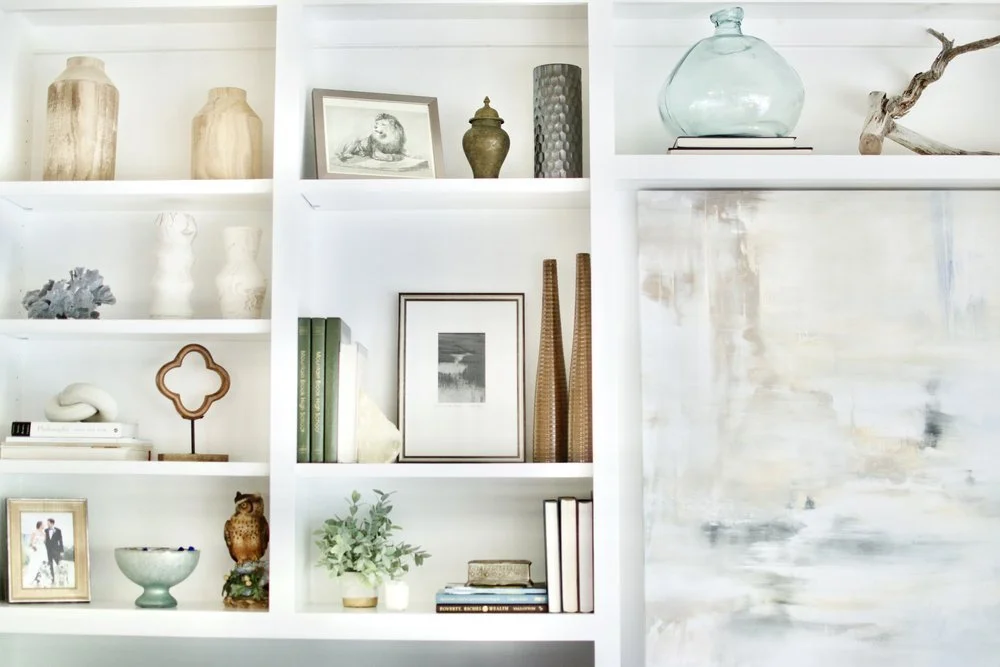How to Style a Bookcase - 6 Rules to Follow
Learn how to style a bookcase like a professional
*This post may contain affiliate links, which means I may receive a small commission, at no cost to you, if you make a purchase through a link*
How to style a bookcase
When you begin, pull in all of the items that you hope to use. I like to start with everything laid out so it is easy to see and pull from. I start by adding frames or bigger items in. Think about the amount of space certain items will take up. Place all of the bigger items first. Then begin layering all of the other items. Don’t be afraid to play around with the overall design! You can move things multiple times until it feels like a good fit. If you aren’t liking the way it looks, move things around or start over! It is a process so keep that in mind as you are styling. Mixing accessories with books but always go with a “less is more” thinking.
Layer, Layer, Layer
An easy way to layer is by adding larger framed art or pictures to the back wall of your shelves. This adds depths and is a great way to add a splash of color or pattern. You can also layer your framed pieces by staggering different size frames on top on one another.
Stacking books horizontally is a great base for layering. Once you have stacked a few books on top of one another you can begin to add different accessories on top of your books. In the picture above I added a wooden knot on top of my books, but you can always add more items depending on how much space you have. Try to work in groups of 3 or really any odd number. Odd numbers catch the eye! On some stacks of books you may have room to add a picture frame at your tallest piece, a small plant beside it and then an scented candle—just make sure if you light your candle it is far enough away from your plant or other decorative pieces to prevent a fire.
When creating layers, don’t forget to use items that have different heights. Most of the time when you feel like something is missing from a display, there’s a good chance you simply need items of various heights. Various heights catch the eye as opposed to everything being on an even playing field. Candle sticks are a great way to add various heights especially if you only have room on your shelf for narrow items.
2. Stick to a color scheme
Generally speaking, bookcases or built-ins are not the main decor element of the room. These generally serve as an accent element to your space. If you have a certain color scheme within the room, your bookcases should mimic that palette. You don’t want your shelves to compete with everything else in your space. To create a cohesive look, make sure to bring in elements that work with the existing style. I used lot of neutral accessories and mixed in a little green and blue for my living room built ins. This added to the overall look of the space without overpowering the other design elements.
3. Style with “less is more” in mind
“Less is more”—-a motto I try to live (and decorate) by. It can be tempting to try to fill every square inch of your bookcase with books, accessories and all the things, but I want to encourage you to refrain from completely filling your shelves. I’ve discovered that styling in groupings is key. It’s important to leave space between your grouping to accomplish a clean and intentional look. Each little grouping can tell a story.
4. Use a mix of items
This is my favorite tip because this is where things really get fun. I would say this “rule” is where a lot of personality is able to come in. Of course I style my bookcase with books, but I don’t stop there. When adding books to my shelves I like to create groupings of books and then leave space beside the groupings so I have room to display vases, sculptural pieces, plants, framed pictures and art and natural elements like driftwood.
I am a firm believer in decorating a space to nor just make it beautiful and aesthetically pleasing, but also creating a space to be a reflection of you and your family’s story and culture. When I styled my bookcase I incorporated art from my travels, framed pictures from my wedding day, photos of my kiddos, pottery I have acquired over the years, original art and other pieces that have sentimental value and meaning behind them. Not every piece has a story behind it. I have a set of checkered decorative boxes that are from Target on my shelves as well. To me, I like a mixture of items that are more personal as well as items I have found at stores like Anthropologie, World Market and local shops—it’s all about balance, right?
Old and new. Don’t be afraid to mix in antiques or vintage finds! These items have so much character!
Greenery has a way of tying a space together, so feel free to add all the flowers and plants to your shelves. Real, faux, lively or dried. Just use whatever YOU like. If you don’t have a green thumb or don’t want to have to keep up with a watering schedule, don’t feel pressured to run off to Home Depot to buy tons of house plants. If you are a fan of real plants, then I recommend using trailing plants on your shelves like String of Pearls or Pothos. These plants break the barrier between shelves and add a beautiful new dimension to your space. You can find realistic faux String of Pearls and Pothos if you would prefer an artificial plant. What I love about these plants is they prevent shelves from being so “boxed in” and add movement to a space.
Natural elements typically have a lot of nice texture, so consider using dried grapewood or driftwood. These wooden elements also add fun sculptural shapes that aren’t uniform. You can also use decorative bowls and boxes and fill them with stones or moss balls.
Play with different textures. Consider incorporating wooden pieces, metals, fabrics, terra-cotta, etc.
Tip: Not every vessel has to have something in it. While it’s nice to display stems in vases and fill up decorative bowls and boxes, don’t feel like you have to. A lot of times I leave my vessels empty because the shape of my vessel is a statement all by itself.
5. Display books in stacks vertically and horizontally
Books are one of my favorite things to incorporate when styling shelves. They are a simple solution to adding height to a space as well as texture and color. I like to mix up my book groupings by stacking them in a pile and also displaying them vertically. Most of the time I remove the “book jacket” from my hardcover book for a clean look and because 9 times out of 10 there are beautiful solid colors underneath the book jacket. Removing the book jacket can eliminate the busyness from the varying designs on different books and create a looks that flows together effortlessly.
In most of the pictures in this blog post I have regular reading books, but coffee table books are also essential when decorating bookcases. Coffee table books are typically a bit larger than reading books which is wonderful because it introduces a new size accessory and helps create more height. I like to group my coffee table books in odd numbers. If you decide to group your books its best to leave some space around each pile so the stacks look deliberate and neat instead of cluttered and accidental.
You can theme your book groupings based on color or subject matter or if you want to style your shelves more outside of the box you can mismatch patterns and colors.
To create a balanced look when decorating with books, I recommend using your small books on the top shelves and your larger read (usually coffee table books) on the bottom shelves.
Tip: You can display books with their binding facing outward for all to see or you can style them “backwards” in order to see the texture of the pages.
6. Work in groups of 3
Working in groups of three brings interest to your space. Adding in different elements like frames, accessories, books, sculptures, and more brings interest to your shelf. It’s best to mix things with different sizes. You want to fill the space without overpowering it. I like to think in small, medium, large when selecting my grouping. Arrange your items in odd numbers for an organic and natural look.













